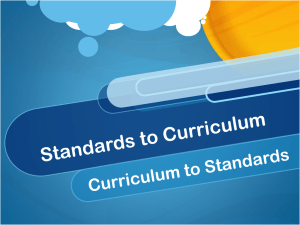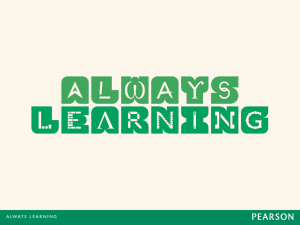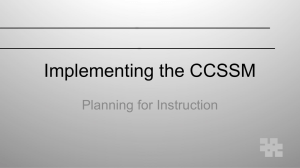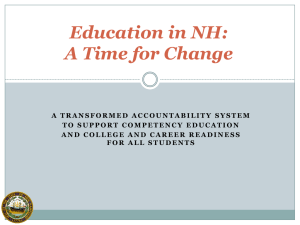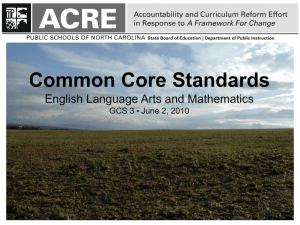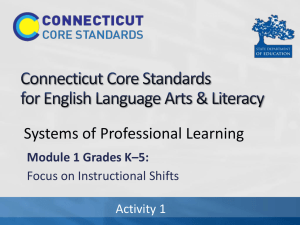Learning Progression - MAST
advertisement
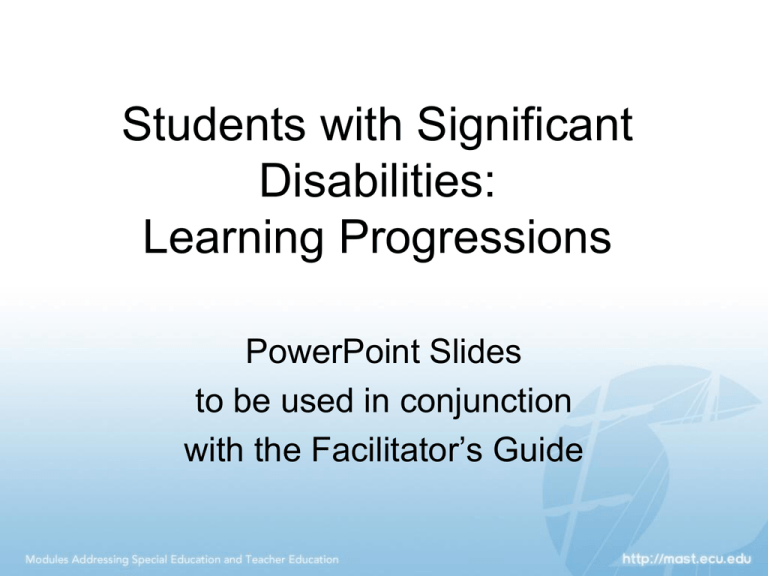
Students with Significant Disabilities: Learning Progressions PowerPoint Slides to be used in conjunction with the Facilitator’s Guide Copyright © 2011, East Carolina University. Recommended citation: Hess, K. (2012). Students with significant disabilities: Learning progressions – A PowerPoint presentation for professional development. Modules Addressing Special Education and Teacher Education (MAST). Greenville, NC: East Carolina University. This resource includes contributions from the module developer and MAST Module Project colleagues (in alphabetical order) Kelly Henderson (Facilitator Guide Editor), Tanner Jones (Web Designer), Diane Kester (Editor), Sue Byrd Steinweg (Project Director), Bradley Baggett (Graduate Assistant), and Sandra Hopfengardner Warren (Principal Investigator). Session Agenda • • • • Introduction Session Goals and Objectives Set the Course Current Alternate Assessment Designs and Design Challenges • Distinguishing among Access Skills, Foundational Skills, and Academic Content • Evaluation Introduction • What promise do learning progressions hold for Alternate Assessments based on Alternate Achievement Standards (AAAAS)? • “A Horse Story”- Read page 1 of Developing and Using Learning Progressions as a Schema for Measuring Progress, (see Guide and available at http://mast.ecu.edu/modules/lpssd/lib/doc uments/CCSSO2_KH08.pdf .) Introduction, continued • How is the training of this head-shy horse similar to applying a learning progressions schema to instruction and assessment for students with significant cognitive disabilities? • The concepts behind the horse story and possible answers to the open-ended question will be addressed throughout the session and revisited in the self-assessment. Session Goal and Objectives • The goal of this module is to deepen participants’ understanding of what learning progressions are and are not and how the use of learning progressions can influence: (a) teacher perceptions of what students can learn, (b) entry points for learning, (c) classroom teaching and assessment practices, (d) test designs for developing content and measuring progress in alternate assessments based on alternate achievement standards. Session Objectives, continued Objectives: Participants will be able to: 1.Match each common alternate assessment design (checklist/rating scale, performance tasks, and portfolios) with its description and identify at least one major challenge currently presented by each. Session Objectives, continued 2. Distinguish age-appropriate academic content for inclusion in alternate assessments from foundational skills and/or access skills. Session Objectives, continued 3. Identify examples and non-example of content-specific learning progressions, applying two guiding principles of learning progressions: having a common unifying thread and demonstrating increasing complexity, breadth, or sophistication (novice to expert). Set the Course • What are “learning progressions”? • For the answer, review one of these articles: – Nichols (2010). What is a learning progression? Available at http://mast.ecu.edu/modules/lpssd/lib/documen ts/Bulletin_12.pdf or Set the Course, continued – Clements & Sarama (2009). Learning trajectories in early mathematics – sequences of acquisition and teaching. Encyclopedia of Language and Literacy Development at http://literacyencyclopedia.ca/index.php?fa=ite ms.show&topicId=270 , pages 1 and 2, or – Hess (2008): Developing and Using Learning Progressions as a Schema for Measuring Progress. Available at http://mast.ecu.edu/modules/lpssd/lib/docume nts/CCSSO2_KH08.pdf#page=2 Set the Course, continued • Key ideas to remember about learning progressions: – Learning progressions are based in research about how children typically learn and develop understanding in each content domain. – Learning progress depends on combining best practices in instruction with clear learning targets, not simply “natural” development over time. Set the Course, continued – There are several possible inter-related pathways learning progressions can take, depending on the unifying ideas being learned over time. – Learning progressions are hypotheses about how learning will occur that must be validated with actual students/student work samples. Set the Course, continued Connecting the Four Guiding Principles of LPs to assessing students with severe cognitive disabilities. Principles include: 1. LPs are developed (and refined) using available research. 2. LPs have clear binding threads that articulate the essential/core concepts and processes. 3. LPs articulate movement toward increased understanding. 4. LPs go hand-in-hand with well-designed/ aligned assessments. Set the Course, continued Principle 1: LPs are developed (and refined) using available research. • Little existing research about how students with significant cognitive disabilities (SWSCD) learn academic content. Why? – SWSCD have not been expected to learn (due to AA-AAS content assessed) and have not been taught academic content; Set the Course, continued – teachers of SWSCD often lack content expertise needed to design meaningful academic learning that is grade-appropriate; and – perhaps an underlying belief that SWSCD cannot or do not need to learn academic content. Set the Course, continued • The National Alternate Assessment Center (NAAC) believes that academic learning progressions for the general student population can serve as a starting point for designing learning for SWSCD. – National content experts and master teachers from both general and special education have been working to develop a learning progressions framework using the Common Core State Standards (CCSS). Set the Course, continued – While the CCSS are not necessarily researchbased in their development, the NAAC committees have applied cognitive research to the development of the NAAC Learning Progressions Frameworks (LPFs) for ELA, mathematics, and science. – Once piloted by teachers in 2010-2012, the NAAC LPFs will be validated and refined using student work analyses and teacher observations about how SWSCD learn gradeappropriate academic content. Set the Course, continued Principle 2: LPs have clear binding threads that articulate the essential/core concepts and processes. • Development of Learning Progression Frameworks using the CCSS began with identifying the unifying threads, big ideas, of each content discipline. T Set the Course, continued • These big ideas were used to articulate key learning targets for a progression across grade levels that would demonstrate learning of the big ideas. – This key component – an articulated continuum of learning - has been missing in the discussion of learning progress, not only for SWSCD, but for the general population as well. Set the Course, continued • To see the NAAC LPF big ideas, read “Identifying learning progressions in Common Core State Standards for alternate assessments” at http://www.nciea.org/publications/ASE S_%20KH2010%20edits.pdf Set the Course, continued Principle 3: LPs articulate movement toward increased understanding. • After establishing the big ideas (unifying threads) for the NAAC learning progressions, development of grade span learning targets began. – Careful thought was given to how these learning targets should be “ordered along a continuum” for academic learning across grade levels. Set the Course, continued – In many cases, several big ideas and thus several sets of learning targets were established with the expectation that student would be learning content described in not just one single progression, but from several interrelated progressions. – Review an example LP at http://mast.ecu.edu/modules/lpssd/lib/docum ents/ME_example.pdf. Set the Course, continued Principle 4: LPs go hand-in-hand with well-designed/aligned assessments. • In a recent 3-year study, researchers worked with the Hawaii Department of Education and teachers grades K-8 to develop Progress Maps (learning progressions) for mathematics and ELA grade-level benchmarks. Set the Course, continued • Teachers were asked to track the progress of struggling learners in their classrooms using formative assessments aligned with the progress maps and collaborative student work analysis to support learning. • Findings from this research study showed that use of learning progressions with aligned formative assessments and student work analysis affected: Set the Course, continued – Changes in teachers’ perceptions of teaching to the content standards – Teachers began to understand what a path to proficiency or “approaching proficiency” might actually look like for a specific grade level. – Many teachers reported they had been using the grade-level benchmarks for years, but never really understood them in this way (how to get to “there” from “here”). Set the Course, continued • Changes in teachers’ perceptions of low performing learners: – Teachers found they had to know the student better to “place them” on a learning continuum – they needed specific formative assessment data and designed assessments accordingly. – Teachers began to see students according to what the students COULD do, not what they COULD NOT do (some said it was the first time they had not seen students as “behind the others”). Set the Course, continued – Said that indicators in the progressions presented the “big picture” of what students could do that they could build on and use them with parents and students alike. • Changes in teachers’ day-to-day assessment practices: – Pre-assessments were used as “entry points” to differentiate instruction. – Pre-assessments focused on the prerequisite skills needed to be successful, not the “end point” of the continuum (i.e., the benchmark). Set the Course, continued – Teachers’ use of pre-assessments increased the use of formative assessment data, including using it as new way to flexibly group students for targeted instruction/support – Teachers' assessments – both formative and summative - had greater focus and therefore assessment data are more useful. Set the Course, continued • These research findings - along with other anecdotal feedback from teachers - give us hope that the use of welldesigned learning progressions for planning both instruction and assessment for students with significant cognitive disabilities will greatly impact teacher practice and student learning (Hess, June 2010). Current Alternate Assessment Designs and Design Challenges • “States typically begin development of their AA-AAS by adopting a general method to assess all students participating in the alternate assessment system; however, the specific assessment tasks and the breadth and difficulty of content included for assessment vary widely from state to state, even when the test designs are similar” (Hess, Burdge, & Clayton, in press, p. 3). Assessment Designs, continued • Three most commonly used approaches for alternate assessments (Roeber, 2002): – A portfolio/body of evidence is a purposeful and systematic collection of student work, collected over time and graded by the teacher. Overall performance is evaluated and judged against predetermined scoring criteria (e.g., accuracy, independence, complexity), usually described in a rubric and usually by one of more scorers other than the teacher. Assessment Designs, continued – A performance task/event is a direct, ondemand measure of a skill in a one-to-one assessment situation (e.g., the student responds to questions about the plot in a preselected, grade-level, fictional text) and the teacher scores the student responses according to an answer key. Performance tasks are highly structured and scripted for the teacher, which strengthens standardization of administration and technical quality. Assessment Designs, continued – A rating scale/checklist is a sequential listing of skills, tasks, or activities and requires teachers to identify whether students are able to perform them or not. Scores are then based on the number of skills the student is able to perform successfully. Teacher recall and observation, not student work samples are used to evaluate and make judgments about performance. Assessment Designs, continued • Each common alternate assessment test design struggles to find the balance between standardization of administration and flexibility to meet individual student needs (Gong & Marion, 2006). • The following table summarizes some strengths and challenges of alternate assessment designs (adapted from Hess, Burdge, & Clayton, in press, p. 9). Common AA-AAS Test Designs Major Strengths Portfolios • • Performance Tasks • • Checklists/ Rating Scales • • Major Challenges Links between curriculum, instruction, and assessment are more obvious than in other test designs because the work samples are collected over time. Teachers have the flexibility to customize assessment tasks to meet individual student needs. • Teachers are provided with structured tasks, increasing standardization of administration. With training, can provide a high degree of standardization of performance tasks, increasing technical adequacy. • Standardized across standards assessed, but are flexible in that assessment activities are developed by teachers with specific student needs in mind. Have some of the same flexibility and standardization issues as with portfolio formats. • • • • Requires teacher content expertise in order to develop multiple assessment tasks in each content area. Too much flexibility – individual customization can result in lack of standardization and an overall lack of technical quality. In other words, students are not being tested on the same academic content and constructs. Requires extensive development of comparable assessment tasks that can be used across large numbers of students and rotated yearly. Less flexibility in terms of tailoring the administration and performance to a particular student’s needs – tasks are the same across students and some students might be excluded. Variability in scoring is often noted; sometimes a second scorer is needed to attain scoring reliability Often lack student work samples to validate scores/judgments about proficiency. Activity - Assessment Designs • Look at the two tables of examples of Alternate Assessments, provided to you or found at http://mast.ecu.edu/modules/lpssd/summ ary/#1. Assessment Designs, continued – Example #1: While no access skills are assessed on the Academic Learning – Alternate (VITAL-A), teachers are encouraged to have students practice use of access skills during learning of academic content. Access skills and foundational skills become the means, not the end in academic learning. Academic skills and concepts become increasingly more complex over time/across grades 2-5. Assessment Designs, continued – Example #2: Here is a science inquiry example for grades K-5. Academic skills and concepts become increasingly more complex over time/across grades. • After examining both examples, reflect on how the distinctions between access skills and foundational skills. • Then discuss the progressions presented in the right hand columns. Distinguishing among Access Skills, Foundational Skills, and Academic Content • Academic content has been underrepresented in past instruction and research with students with significant cognitive disabilities. Distinguishing Skills, continued • Therefore, the “extension” of grade-level content standards for AA-AAS can sometimes produce assessment targets that miss the mark of being academic, even though a deliberate development process was used to make “links” to the alternate assessment targets (Flowers, Browder, Wakeman, & Karvonen, 2007). Distinguishing Skills, continued • To determine whether the content is academic (i.e., reading, writing, mathematics, or science content) and to what degree the AA-AAS includes academic content for instruction and assessment, one must examine the strength of the content links between the grade-level content expectations and the content assessed in the AA-AAS at the same grade level or grade span. Distinguishing Skills, continued • In the following table, there are examples of content that would not be appropriate to include in AA-AAS assessments because they are only skills that facilitate learning of academic content, but are not considered academic (adapted from Hess, Burdge, & Clayton, in press, p. 13). Access Skills (skills not content-specific, but often included in IEP goals that facilitate learning) • • • • • • • Student sustains interest in a teacherdirected activity. Student listens attentively to texts read aloud. Student develops gross motor skills. Student develops fine motor skills. Student activates a switch to respond. Student uses a communication device. Student demonstrates visual and auditory discrimination. Foundational Skills (skills that form the basis or foundation for learning the academic content that comes later) Reading & Writing • Student demonstrates concepts of print: tracks print. • Student learns letters and sounds. • Student distinguishes letters from words. • Student generalizes use of pictures, symbols, objects, and actions to identify their meaning. Mathematics • Student identifies numbers. • Student counts objects using 1:1 matching. • Student distinguishes numbers from letters. Science • Student follows a one-step direction. • Student can identify an obvious external physical difference (e.g., color, size, shape) in objects. Activity - Distinguishing Skills • Look at the fill-in table of access and foundational skills for writing provided or at http://mast.ecu.edu/modules/lpssd/lib/docu ments/Activity02.pdf • Complete some examples of access skills and foundational skills for this learning progression in writing (Source: Adapted from Biggam & Itterly. (2009). Literacy profiles: A framework to guide assessment, instructional strategies and intervention, K-4). Focus and Reflection Questions Focus and Reflection Questions, continued Application and Extension Activities Application and Extension Activities, continued Application and Extension Activities, continued Self-Assessment • A self-assessment with response feedback is available at http://mast.ecu.edu/modules/lpssd/quiz/. Participants may take this assessment online to evaluate their learning about content presented in this module. Session Evaluation • A form for participants to evaluate the session is available in the Facilitator’s Guide.
